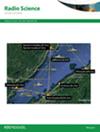Adaptive moment estimation for polarimetric weather radar using explainable deep learning-based estimators
IF 1.5
4区 地球科学
Q3 ASTRONOMY & ASTROPHYSICS
引用次数: 0
Abstract
This paper presents machine learning-based approaches to improve moment estimation for polarimetrie weather radar. A novel weighted multilag estimator (WMLE) is proposed, with adaptively learned weights optimized using deep learning techniques. Two approaches of multilayer perceptron (MLP) and convolutional neural network (CNN) are used to implement WMLE. The performance of WMLE is evaluated using the measurements from the Next-Generation Weather Radar (NEXRAD) system. Experimental results demonstrate that the WMLE significantly improves polarimetric data quality, achieving lower root mean square error and standard deviation compared to conventional 0-Lag and 1-Lag estimators. In addition, the CNN-based estimator surpasses its MLP counterpart by leveraging spatial information in the input data and producing content-aware dynamic adaptive weights. Furthermore, the CNN-based estimator achieves superior radar data quality using data from only 32 pulses, compared with the 0-Lag and 1-Lag estimators using 64 pulses. Moreover, the CNN model demonstrates physical explainability, as its learned weights exhibit meaningful correlations with the characteristics of NEXRAD data.基于可解释深度学习的极化气象雷达自适应矩估计
本文提出了一种基于机器学习的方法来改进极化气象雷达的矩估计。提出了一种新的加权多滞后估计器(WMLE),该估计器使用深度学习技术自适应学习优化权重。采用多层感知器(MLP)和卷积神经网络(CNN)两种方法实现WMLE。利用下一代天气雷达(NEXRAD)系统的测量数据对WMLE的性能进行评估。实验结果表明,与传统的0-Lag和1-Lag估计器相比,WMLE显著提高了极化数据质量,实现了更低的均方根误差和标准差。此外,基于cnn的估计器通过利用输入数据中的空间信息和产生内容感知的动态自适应权重,超越了其MLP对应的估计器。此外,与使用64个脉冲的0-Lag和1-Lag估计器相比,基于cnn的估计器仅使用32个脉冲的数据就能获得更好的雷达数据质量。此外,CNN模型显示了物理可解释性,因为其学习的权重与NEXRAD数据的特征表现出有意义的相关性。
本文章由计算机程序翻译,如有差异,请以英文原文为准。
求助全文
约1分钟内获得全文
求助全文
来源期刊

Radio Science
工程技术-地球化学与地球物理
CiteScore
3.30
自引率
12.50%
发文量
112
审稿时长
1 months
期刊介绍:
Radio Science (RDS) publishes original scientific contributions on radio-frequency electromagnetic-propagation and its applications. Contributions covering measurement, modelling, prediction and forecasting techniques pertinent to fields and waves - including antennas, signals and systems, the terrestrial and space environment and radio propagation problems in radio astronomy - are welcome. Contributions may address propagation through, interaction with, and remote sensing of structures, geophysical media, plasmas, and materials, as well as the application of radio frequency electromagnetic techniques to remote sensing of the Earth and other bodies in the solar system.
 求助内容:
求助内容: 应助结果提醒方式:
应助结果提醒方式:


